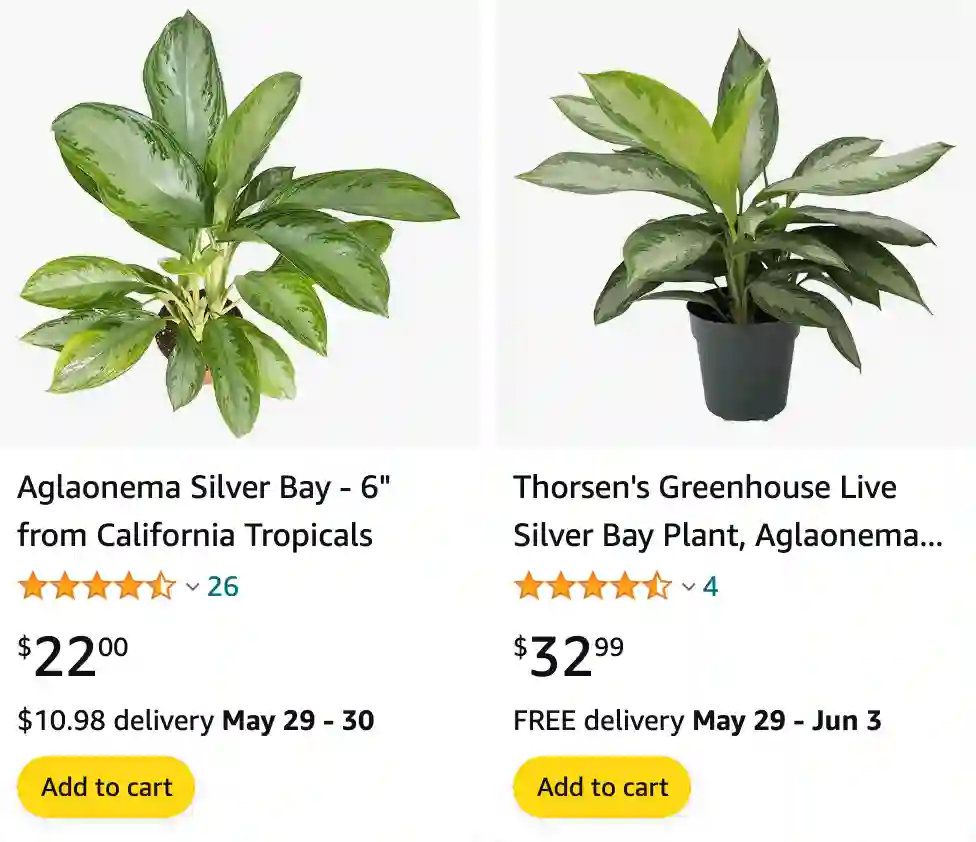
Aglaonema Silver Bay vs Emerald Bay
Between Aglaonema Silver Bay and Aglaonema Emerald Bay, I found Silver Bay’s lighter green hues more soothing, while Emerald Bay’s darker, richer tones added a bold contrast in my living room decor.
Aglaonema Silver Bay vs Silver Queen
Aglaonema Silver Bay and Aglaonema Silver Queen both have striking patterns, but Silver Bay’s larger leaves and stronger variegation stood out more to me, adding a vibrant touch to my workspace compared to the subtler elegance of Silver Queen.
How to care for Aglaonema Silver Bay?
The Aglaonema Silver Bay is a popular houseplant known for its beautiful variegated leaves and adaptability. Here’s a quick guide on how to care for it:
Light:
- Prefers indirect sunlight. Avoid direct sunlight, especially the harsh afternoon sun.
- Can tolerate low light conditions but may grow slower.
Watering:
- Water moderately, allowing the soil to dry slightly between waterings.
- Avoid overwatering, which can lead to root rot.
- Watering frequency depends on season and pot size. Generally, water once a week in summer and less often in winter.
- Use a pot with drainage holes to ensure excess water can escape.
Humidity:
- Can tolerate average household humidity levels.
- Thrives with increased humidity, especially if grown in drier climates or during winter. You can mist the leaves occasionally or use a pebble tray to increase humidity around the plant.
Additional care tips:
- Fertilize occasionally during the growing season (spring and summer) with a balanced houseplant fertilizer.
- Wipe leaves occasionally with a damp cloth to remove dust and improve air circulation.
- Remove any dead, discolored, or diseased leaves to maintain the plant’s appearance and health.
How to propagate Aglaonema Silver Bay?
When I propagate my Aglaonema Silver Bay, I usually do it by division. I carefully take the plant out of its pot and gently separate a section with a few stems and roots. I then plant the divided section in a new pot with well-draining soil, water it lightly, and keep it in a warm spot with indirect light. This method has worked well for me and helps to keep the plant manageable in size.
Are Aglaonema Silver Bay poisonous to cats?
I was worried when I first got my Aglaonema Silver Bay because I have a cat, and I found out that it’s indeed toxic to cats. If ingested, it can cause symptoms like mouth irritation, drooling, and difficulty swallowing. Because of this, I make sure to place the plant in areas where my cat can’t reach it, like high shelves or in rooms that I keep off-limits to my feline friend.
Does Aglaonema Silver Bay bloom?
I was surprised to learn that my Aglaonema Silver Bay can bloom! It produces small, greenish-white flowers that are somewhat inconspicuous compared to its striking foliage. The blooms appear sporadically and are not particularly showy, but I find them to be a charming bonus to the beautiful leaves.
How to care for an Aglaonema Silver Bay indoor plant?
For my indoor Aglaonema Silver Bay, I ensure it’s in a pot with drainage holes and use a well-draining potting mix. I place it in a spot with bright, indirect light and avoid any cold drafts or sudden temperature changes. Regularly checking the soil moisture and adjusting watering frequency based on the season helps keep it thriving. Additionally, I prune any yellow or dead leaves to encourage new growth and maintain its appearance.
How to take care of Aglaonema Silver Bay?
Taking care of my Aglaonema Silver Bay involves keeping a consistent watering schedule, ensuring it gets the right amount of light, and maintaining proper humidity levels. I also make sure the soil is slightly acidic to neutral and occasionally rotate the plant to ensure even growth. I’ve found that a little bit of extra attention, like occasional misting and cleaning the leaves, goes a long way in keeping it healthy.
Why is my Aglaonema Silver Bay drooping?
When my Aglaonema Silver Bay started drooping, I realized it was either due to overwatering or underwatering. I checked the soil, and it was too soggy, indicating overwatering. I let the soil dry out a bit before resuming a more balanced watering schedule. Another time, it was due to low humidity, so I started misting it more often and placed a humidity tray nearby. Adjusting these factors helped the plant perk up again.




